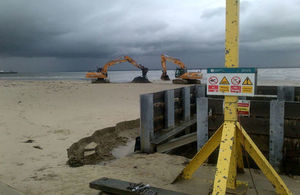Environment Agency begins work on £5million Isle of Wight Flood Scheme
More than 300 local properties in Ryde will be better protected from flooding

The outfall at Monktonmead - picture shows work being carried out at outfall pipe on a beach, with two mechanical diggers behind
On 1 March Environment Agency contractors are starting construction of a new £5 million flood scheme to better protect more than 300 properties in Ryde. In partnership with the Isle of Wight Council and the Southern Regional Flood and Coastal Committee, the completed scheme will significantly reduce flood risk in the area.
Environment Agency Manager John O’Flynn said:
We are delighted to be launching this multi-million pound scheme on the island, which includes over £1 million of partner contributions that will benefit so many local homes and businesses. A sensible approach to funding and a good relationship with our partners has allowed us to begin the work in early spring. We’ll now be able to minimise disruption to the beach in the summer, avoid environmental constraints (including overwintering birds) and deliver a completed scheme that will reduce the flood risk by the autumn.
Environment Minister Thérèse Coffey said:
We are investing £2.6 billion to better protect the country from flooding, including over 1,500 flood defence schemes which will better protect 300,000 homes by 2021. The Isle of Wight scheme is an important step in building our resilience, protecting more than 300 homes and businesses locally and giving people all important peace of mind.
Cabinet member for environment and heritage Councillor John Hobart, said:
Together with our partners, we are making great progress on flood prevention measures for Ryde and we are working alongside the Environment Agency and the Southern Regional Flood and Coastal Committee to reduce the risk of floods in the long term. We are excited to see this work beginning early spring to further strengthen flood measures for the residents of Ryde and surrounding habitat.
The first stage of the project is to build a new outfall pipe from the sea wall in front of the existing pump station across Ryde sands to the marina. This will mean a clear outfall is maintained allowing more water to be discharged to the sea in heavy rainfall events and a significant reduction in the frequency of river flows overtopping the bank and flooding land and properties in Ryde.
This work will result in the closure of the section of beach from the existing outfall to Ryde Marina. The Environment Agency expects these essential works to be completed in July 2018, allowing it to reopen for the summer holidays. Although the children’s play area next to the public toilets will be used as a works compound, it will be replaced at the end of the project.
The second and final stage is the construction of a flood wall around Simeon Street Recreation Ground, Marymead Close and the river boundary of the BT depot. These works are planned to start in June 2018 and be completed by October 2018.
Anyone who would like to find out more about the scheme or ask questions, is welcome to come along to the next Ryde Flood Action Group Meeting which will be held at the Simeon Arms on 13 March at 5:00pm. There will also be an open day later in the spring where the Environment Agency will present a detailed design of the flood wall that constitutes the second stage of the project.
NOTES TO EDITORS
The Monktonmead Brook drains a catchment of approximately 10km2 and flows north into the sea via an outfall at Ryde, Isle of Wight. A culvert carries flows the last 170m to the sea wall and a pumping station, after which a 60m long culvert (an underground pipe) carries water to an outfall on the beach. Flows usually drain through gravity. A tidal flap at the sea wall closes against high tides leading to tide locking. High water levels in the Brook trigger operation of the pumps, which lift water over the seawall and into the last 60m of outfall.
As a result of tidal processes, sand has accumulated on the beach surrounding the end of the outfall leading to its regular burial. This sand migrates up the culvert towards the sea wall restricting flow through the outfall. Despite an automatic increase in pumping, the restriction of flows causes water to back up in the Brook, leading to an increase in flood risk to Ryde.
All media enquiries: 0800 141 2743
Please ask for the duty press officer.